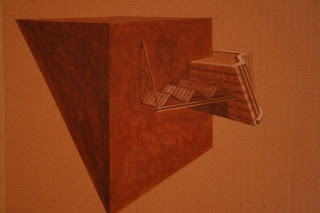

Chris Clements’ new show ‘Dig’ takes its inspiration from fields as diverse as Kyoto screen painting, Pop Art and Art Povera to plunge the viewer into a parallel world of post-apocalyptic chic. Chris is showing a collection of drawings and constructions that will appeal to the casual gallery hopper while also providing the art geek with an oblique texture to chew on. His work is quietly self-assured while maintaining a humility and casualness that finds it sitting as comfortably in the hallway of a ramshackle villa as on the distinguished walls of a contemporary art museum. The delicately tailored constructions and fine linear gouache drawings demonstrate a solid conceptual framework offset with an incisive wit and irrepressible playfulness that characterises this artist’s dynamic practice.





Chris Clements’ paintings at HSP
I used to imagine some strange things as a child. Mostly, these imaginings are almost impossible to explain to other people. They are almost sensations, or bizarre little patterns that I forced myself to create for some reason, like turning a light switch on and off three times before leaving a room. I used to think that maybe I was an obsessive compulsive, but now, after talking to some other people, I realize that lots of kids create these kind of systems. It is a way of negotiating the world, or maybe when we are younger we are just more fanciful and could think of more fantastical things. I don’t know, maybe I’m just weird.
Anyway, I used to invent a lot of these situations when we were driving in the car. In particular, I used to imagine that attached to the side of our car was a giant knife, extending directly out from the door, so as to slice through everything on the side of the road. I would imagine trees, houses and fences chopped in half. It wasn’t really a violent thing, I didn’t want to chop up people or anything, I just envisaged severing parts of the countryside. Things would split and fall apart, trees and hedges would tumble to the ground. It was almost as if the power and force of our car was causing irreparable damage to the countryside. I used to think about this when I was a kid, staring out the car window.
It was the first thing I thought of when I looked at Chris Clements’ paintings. They are drive-by visions where huge sections of the landscape have been removed, rendering the objects mysteriously calm and almost completely autonomous. They give the sensation of the fleeting glimpse one gets when zipping past something on the motorway. A median strip, a verge, some road works, a flash of grass, all these are ephemeral and slide away quickly, before you have a moment to realize or fully compute their form. Clements’ pins down these particulars, he paints a strip of asphalt and a verge-side piece of grass with delicacy and clarity. But then he strips them of any context, and they are alone in an empty landscape of white.
What does it mean to de-contextualise these elements? What does it mean to cast them adrift on the empty picture plane? I find that their sense becomes harder to ascertain. What exactly they signify is unclear. Some semiotic theorists have argued that words create meaning simply because of what they not. It is a relational argument; the word ‘cat’ only signifies its meaning by not being the word ‘dog’. Therefore, meaning is generated through difference. Visually, we also require difference to guide us through a field of signs. When objects appear in a painting, they convey their meaning not only through their obvious visual relationship to the world they mimic, but also through their difference from their counterparts, and to the context in which they are placed. Context helps us to construct narrative, form associations and decode denotations.
Clements’ isn’t very helpful. He doesn’t give us any of this. He gives us little parts of an environment and expects us to work with these tid-bits. In doing so, the power in the work swings from the positive elements, the painted areas of grass and the tiny spades, to the negative elements, namely the wide empty space of blank paper. These are the most arresting and powerful parts of the works. Clements’ wrote his Masters on the subject of liminality, and you can see that interest coming to the fore here. It is the liminal space, the space in between, that interests the artist most. In these paintings, he shows how it can create energy on the picture plane, cause perspective to skew and twist, and impinge on the painted objects; dominating them with its obsessive quietness.
As part of their Summer Residency at Enjoy Public Art Gallery in Wellington, M&W produced a small booklet on the subject of negative space. I noted that a number of people who contributed wrote that negative space was the space of potential, that it was a space where nothing had happened yet, but something might if you waited around for awhile. I would agree with this assertion in some cases, but interestingly, I think it is actually the opposite in the paintings of Chris Clements. These works reveled in their nothingness. At HSP the white paper spread out and slunk across the walls. In fact, I would have liked to see these works unframed, so as to let the white paper bleed out into the white walls, and the gallery itself would have become a liminal space. Clements’ negative space is not full of potential, or on the cusp of exploding into form, shape and colour, it is just the space in between and is happy to remain that way. It recognizes its complicated role as a placeholder, as the unknown, and in not being.
Thomasin Sleigh
April 2007



